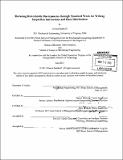| dc.contributor.advisor | Daniel Whitney and Roy Welsch. | en_US |
| dc.contributor.author | Bashkoff, Jessica (Jessica Leigh) | en_US |
| dc.contributor.other | Leaders for Global Operations Program. | en_US |
| dc.date.accessioned | 2013-09-24T19:35:26Z | |
| dc.date.available | 2013-09-24T19:35:26Z | |
| dc.date.copyright | 2013 | en_US |
| dc.date.issued | 2013 | en_US |
| dc.identifier.uri | http://hdl.handle.net/1721.1/80990 | |
| dc.description | Thesis (M.B.A.)--Massachusetts Institute of Technology, Sloan School of Management; and, (S.M.)--Massachusetts Institute of Technology, Dept. of Mechanical Engineering; in conjunction with the Leaders for Global Operations Program at MIT, 2013. | en_US |
| dc.description | Cataloged from PDF version of thesis. | en_US |
| dc.description | Includes bibliographical references (p. 82-83). | en_US |
| dc.description.abstract | Each aircraft on the final assembly line inevitably has minor build errors and deviations from the intended design. Errors, like these, that can be corrected on the line are called reworkable discrepancies. Because hundreds of reworkable discrepancies can occur on each aircraft it is a huge opportunity for improvement and cost reduction. It would be impossible to analyze each one that occurs on the line. However, last year at X Aerospace another researcher created a tool to categorize discrepancies by key words based on free form text describing them. Root cause analysis and corrective action teams were put in place for the highest driving discrepancies but a more exhaustive analysis was not conducted. In this research, to continue the root cause analysis, and gain a more detailed understanding of why discrepancies occur, a single aircraft was followed through final assembly and each discrepancy reviewed. Some key findings of this review were confirmation that the tool created previously was accurate, that there is a time lag between creation of a discrepancy and its discovery upon inspection, and that there is lack of access to specifications and data on the floor. To address the issues with late discovery of discrepancies, more specific and guided inspection instructions are needed. Standard work has been developed for writing inspection instructions that are clearer. They include features such as guided and general tasks, references to specs for all directive instructions, specific locations on the assembly and drawings, and symbols and wording to indicate instruction versus reference information and which contain only instructions relevant for the particular inspection. Changes in management have halted the implementation of the standard work for writing inspection instruction. However, this standard work became the basis for changes being made to improve work instructions. To address the lack of access to data, a tool which collects data and displays a cross Pareto heat map of the highest driving issues on each line, position, and work order has been developed. The line managers have been trained on how to use the tool to determine high driving issues in almost real time and implement corrective actions more quickly. In addition the tool is in use by quality engineers to help guide reduction efforts. | en_US |
| dc.description.statementofresponsibility | by Jessica Bashkoff. | en_US |
| dc.format.extent | 136 p. | en_US |
| dc.language.iso | eng | en_US |
| dc.publisher | Massachusetts Institute of Technology | en_US |
| dc.rights | M.I.T. theses are protected by
copyright. They may be viewed from this source for any purpose, but
reproduction or distribution in any format is prohibited without written
permission. See provided URL for inquiries about permission. | en_US |
| dc.rights.uri | http://dspace.mit.edu/handle/1721.1/7582 | en_US |
| dc.subject | Sloan School of Management. | en_US |
| dc.subject | Mechanical Engineering. | en_US |
| dc.subject | Leaders for Global Operations Program. | en_US |
| dc.title | Reducing reworkable discrepancies through standard work for writing inspection instructions and data distribution | en_US |
| dc.title.alternative | Reducing minor rework through data distribution and standard work for writing inspection instructions | en_US |
| dc.type | Thesis | en_US |
| dc.description.degree | S.M. | en_US |
| dc.description.degree | M.B.A. | en_US |
| dc.contributor.department | Leaders for Global Operations Program at MIT | en_US |
| dc.contributor.department | Massachusetts Institute of Technology. Department of Mechanical Engineering | |
| dc.contributor.department | Sloan School of Management | |
| dc.identifier.oclc | 857788664 | en_US |
